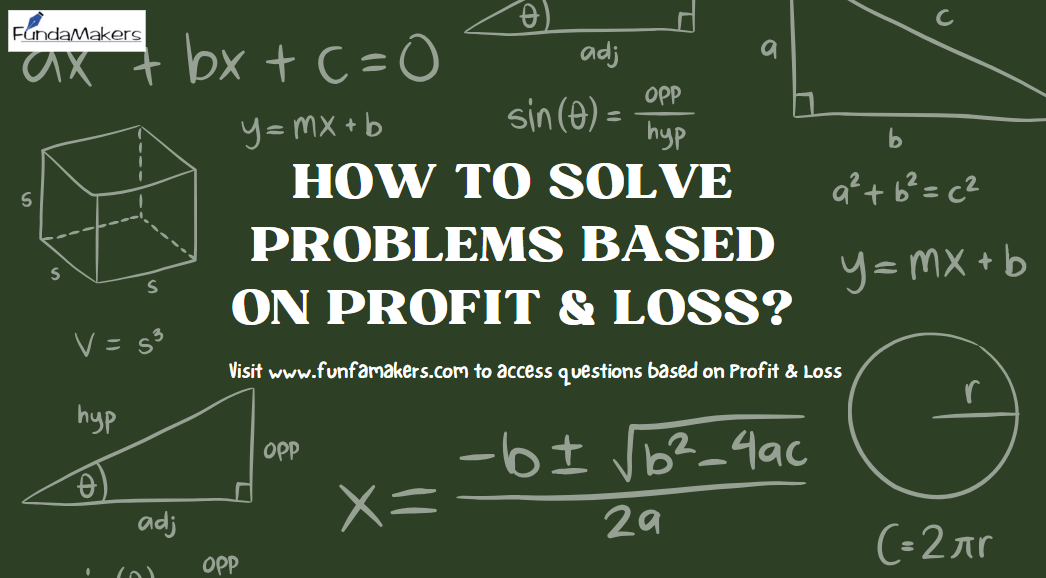Profit & Loss
The Profit and Loss formula is used in mathematics to determine the market price of a commodity and the profitability of a firm. Every product has a cost and a sale price. Based on these pricing, we may compute the profit or loss for a specific product. The key words discussed here include cost price, fixed, variable, and semi-variable cost, selling price, marked price, list price, margin, and so on. We will also learn how to calculate profit and loss percentages here.
Basic Terms in Profit & Loss
When you buy a thing on the market at one price and subsequently sell it at another, you can make a profit or a loss. It is one of the most practical mathematical notions. In everyday life, various forms of transactions occur that involve the concept of profit and loss. Profit and loss concepts are discussed using a variety of words, including the cost price of the product (C.P.), the selling price of the product (S.P.), a discount on the product, the product’s marked price, profit, and loss. The words are explained in the following points.
Cost Price (C.P.)
It refers to the price at which an item is bought in the market. For example, if Amit paid Rs. 15 for a chocolate, the pen’s cost here will also be Rs. 15. It is abbreviated as C.P.
Selling Price (S.P.)
It refers to the price at which an item is sold in the market. For example, if Amit sold the chocolate for Rs. 20, the pen’s selling price will be Rs. 20. It is abbreviated as S.P.
Profit
Within a transaction, if the selling price of a product exceeds the cost price of that product, it represents profit. Using the definition of profit, Amit’s profit is Rs. 5 after selling a Rs. 15 chocolate for Rs. 20. It can be solved using the formula shown below.
Profit = Selling price – Cost price
In the above example, the Cost price of a chocolate was Rs. 15 and the Selling price of the chocolate was Rs. 20. Hence the Profit = Selling price – Cost price = 20-15 = Rs. 5.
Loss
When a product’s selling price in a transaction is less than its cost price, the transaction is considered a loss. For instance, if a toy is bought for Rs. 100 and sold for Rs. 80, there has been a loss of Rs. 20 on the transaction. Utilising the following formula, one can find the loss.
Loss = Cost price – Selling price
In the above example, the Cost price of the toy is Rs. 100 and the Selling price of the toy is Rs. 80. Hence the Loss = Cost price – Selling price = 100-80 = Rs. 20.
Marked Price (M.P.)
It alludes to the cost that the vendor has set by labelling the item. It is regarded as the price at which the vendor offers a market discount. The product is sold for a lower amount, known as the selling price, after the markdown has been applied to the marked price. Rani, for instance, shops in a mall where all merchandise is eligible for a 50% discount. when a stand’s pricing is listed as Rs. 130. It suggests that the stand’s marked price (before the discount) was Rs. 130.
Discount
It alludes to the discount or deal made by retailers or business owners to draw clients to their wares. This kind of offer is typically made to customers by them in order to combat market competition and promote product sales. It is always provided on the product’s marked price. The calculation for the discount is mentioned below.
Discount = Marked Price – Selling Price
Discount (%) = (Discount / Marked Price) × 100
When the marked price labelled on an item is Rs. 160 and there is a 10% discount offer on it, then it implies that the customer can purchase the item at the following rate:
10% discount on marked price = (10/100) × 160
Discount offered = Rs. 16
Hence Selling Price = Marked Price – Discount
Selling Price = 160 − 16 = 144
Profit & Loss Formula
The formula for calculating profit or loss is applied if the product’s cost and selling price are known. When an item’s selling price is greater than its cost, the profit formula is applied. It is discussed below.
Profit = Selling price (S.P.) – Cost price (C.P.)
The loss formula is used when the cost price of an item is higher than the selling price of that item. It is mentioned below.
Loss = Cost price (C.P.) – Selling price (S.P.)
The computed profit or loss is sometimes transformed into a percentage, depending on the requirements of the questions that are asked. The amount of profit or loss incurred is expressed as a percentage in the percentage of profit and loss. It also helps when comparing two specified quantities to one another.
1. Profit percentage (P%) = (Profit /Cost Price) × 100
2. Loss percentage (L%) = (Loss / Cost price) × 100
3. S.P. = {(100 + P%) / 100} × CP (if SP > CP)
4. S.P. = {(100 – L%) / 100} × CP (if SP < CP)
5. C.P. = {100 / (100 + P%)} × SP (if SP > CP)
6. C.P. = {100 / (100 – L%)} × SP (if SP < CP)
Profit & Loss: Solved Examples
Type 1. A shopkeeper buys an article for Rs.1200 and marks it up for sale at a price that it may give him 60% profit on his cost. He however gives 20% discount on the marked price to his customers. Find:
A. Marked price of an article.
B. The discount in rupees to the customer
C. The actual profit made by the shopkeeper.
Solution:
A) M.P.= 1200+ 60% OF 1200
1200+720= 1920
B) Discount %= 20%
20% of 1920 = (20/100) * 1920
= Rs. 384
C) S.P. 1920-384= Rs. 1536
Total Profit= SP – CP = 1536 – 1200 = 336
P% = 336/1200 * 100 = 28%
Type 2: Two articles are sold for the same price such that a profit of 15% is made on one, and a loss of 15% is made on the other. Find the gain or loss percent on the whole.
Solution: Let the C.P. of the first article be x, and the cost price of the other article be y
Profit in article one= 15% of its C.P.= 15/100*100
Profit in the second article = 15/100*y
According to the Question-
x+15/100*x = y-15/100*y
100+15/100*x = 100-15/100 *y
x= 85/115*y (i)
Profit in article one- Loss in the second article/ total selling price of both article * 100
(15x/100 – 15y/100)/ (x +y )* 100
15 (x – y) / x + y
Now substituting x from equation (i), we get
15(85/115) 85/115
For simplifying the expression, we take 115 as the LCM from both numerator and denominator and cancel it. On doing so, we get
15(85-115)/85+115
= – 15*3/ 20 = -3*3/4= -9/4= -2.25
Loss of 2.25%
Type 3. A sold an article to B at 25% profit. B sold it to C at a loss of 12%. If C paid Rs. 1,650, the how much did A pay for it?
Solution:
Profit= S.P. – C.P.
S.P. = C.P. + (C.P. * Profit %)
S.P. = C.P. – (C.P. * Loss%)
Calculation:
Let the article which A bought be Rs. x
A sold it to B at [100x + (100x* 25%)] = Rs. 125x-15x = 110x
Loss of B = (125x-110x) = Rs. 15x
According to the Question, C paid Rs. 1650, i.e.,
110x=1650x=1650/110= 5
So, A bought the article for (100*5) = Rs.1500
Type 4. A sold an article to B at a profit of 25%. B sold it to C at a profit of 15%. The profit made by B is Rs. 40 less than the profit made by A. What is the cost price (in Rs.) of the article for A?
Solution:
Profit= S.P. – C.P. (S.P.= Selling price, C.P. = Cost Price)
S.P. = C.P. + (C.P. * Profit %)
Calculation:
Let A Bought the article for Rs. 100x
A sold it to B at [100x * 25%)] = Rs.125x
Profit earned by A= (125x-100x) = Rs. 25x
So, B bought the article for Rs.125x
B sold it to C at [125x + (125x*15%)] = 143.75x
Profit earned by B= (143.75x – 125x) = Rs. 18.75x
According to Question,
25x – 18.75x = 40
6.25x=40
x=6.4. So,
A bought the article for (100*6.4)= Rs. 640
Thus, the cost price of the article for A is 640.
Type 5. A vendor sells 32 chocolates for RS.1 and loses 40%. In order to gain 20%, how many chocolates should he sell for Rs.1?
Solution:
Formula Used: SP = {(100 – L%)/100} * CP
Calculations:
According to question, we have
SP of 32 chocolates= Rs.1
SP of 1 toffee = Rs. 1/32
(1/32) = {(100-40)/100] * CP
CP= 100/(60*32)
SP = {(100 + P%)/100} * CP
SP= (120/100) * (100/60) * (1/32)
SP= 1/16
Thus, he should sell 16 chocolates for Rs.1 in order to gain 20% profit.
Type 6. A shopkeeper marks up his goods by 20% and gives a discount of 10%. He uses a faulty balance which reads 1000 gm for 800 gm. What is his net profit percentage?
Solution:
Let the customer bought 1 kg of item
Actual amount received by the customer be 800 gm
Let the CP of 1 kg be Rs.100
Actual price of 800 gm = 100*(0.80)= Rs. 80
New marked price= 100+ (20/100)*100*120= Rs.108
Profit earned by the shopkeeper= 100-80= Rs.28
Profit Percentage= (28/800*100 = 35%
Type 7: A shopkeeper bought an article for Rs.1000 and marked its price as Rs.2160. He gave three successive discounts of a%, b%, and c%, where a +b +c= 50. If he made a profit of x% finally, then what is the difference between maximum value of x and minimum value of x?
Solution: First consider that a single discount of 50% is greater than two discounts of 25% each because after the first discount of 25%, the next 25% will be applied on a smaller amount.
So maximum discount will be when when two discounts are 0 and one discount is the entire of 50%
Sale price= 2160*(1/2) = 1080
Profit = (80/1000)* 100= 8%
If sum of all discounts is 50%, each discount is 50/3% = 1/6
Hence, the sale price = 2160*(5/6)*(5/6) = 1250
Profit 250/1000*100 = 25%
Difference between maximum and minimum value of x is 25%-8%= 17%
Test your Caliber with us!
Try your knowledge of this idea by solving the questions given on FundaMakers. Click on ‘Question Bank’ to access the ‘question bank’
Visit the link below to learn how to solve CAT level questions based on Simple & Compound Interest:



